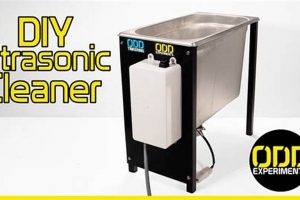A do-it-yourself system designed to capture particulate matter produced during various material processing activities, such as woodworking or metalworking, is often assembled using readily available components. These systems prevent the dispersion of fine particles into the ambient air, thus maintaining a cleaner and healthier workspace. An example would be constructing a collection device using a repurposed vacuum cleaner, a cyclone separator constructed from plastic buckets, and ductwork to direct the airflow.
The fabrication of a particulate collection system from constituent parts provides multiple advantages. It can significantly reduce exposure to harmful airborne debris, potentially mitigating respiratory health issues. Historically, the need for such systems grew with the expansion of manufacturing and woodworking trades. Building one from scratch permits customization to fit specific workshop layouts and equipment needs, often at a lower cost than purchasing a commercial unit. This approach also fosters a deeper understanding of airflow dynamics and filtration principles.
The following sections will delve into practical considerations for designing and building effective particulate extraction solutions, encompassing aspects like component selection, system design principles, and performance optimization strategies.
Essential Guidelines for Effective Particulate Collection System Construction
The subsequent guidelines provide crucial considerations for the design and construction of a self-assembled particulate collection system, emphasizing efficiency and safety.
Tip 1: Component Selection: The blower, filtration medium, and ducting must be carefully chosen. Undersized blowers will lack sufficient suction, while inadequate filtration media will permit fine particles to escape. Ducting material should resist static electricity buildup to prevent fire hazards.
Tip 2: Cyclone Separator Implementation: Incorporating a cyclone separator before the filter increases system efficiency. This component removes larger debris, thereby extending the filter’s lifespan and maintaining optimal airflow.
Tip 3: Airflow Calculation: Understanding the required airflow (cubic feet per minute or CFM) for each piece of equipment is vital. Insufficient airflow renders the system ineffective. Use appropriate formulas and consider pressure drops in the ducting.
Tip 4: Sealing and Leak Prevention: All connections must be airtight. Leaks diminish suction and reduce the system’s overall effectiveness. Use appropriate sealants and clamps to ensure integrity.
Tip 5: Filter Maintenance: Regularly clean or replace filters to maintain optimal performance. Clogged filters impede airflow and reduce suction power, diminishing the system’s effectiveness.
Tip 6: Grounding Considerations: Static electricity can accumulate in particulate collection systems, posing a fire hazard, especially when processing flammable materials. Properly ground the system components to mitigate this risk.
Tip 7: Ducting Layout Optimization: Minimize bends and long runs in the ducting to reduce friction and maintain airflow. Straight, short duct runs are more efficient. Avoid sharp angles where possible.
These guidelines are intended to improve the performance and safety of a self-made particulate management apparatus. Applying these considerations is crucial for protecting both respiratory health and overall workshop safety.
The article will continue with a detailed exploration of safety protocols and potential hazards associated with these systems.
1. Airflow dynamics
Airflow dynamics are fundamental to the functionality of a do-it-yourself particulate collection system. The ability of such a system to effectively capture and remove airborne particles depends directly on the principles governing air movement within the system. Insufficient airflow results in inadequate capture velocity at the source of dust creation, allowing particles to escape into the workspace. Conversely, excessive airflow can lead to filter clogging and reduced system efficiency. For instance, a woodworking shop employing a table saw benefits from strategically positioned inlets that capitalize on natural airflow patterns, ensuring dust is drawn into the collection system before it disperses. The design and placement of ductwork, the selection of an appropriately sized blower, and the minimization of airflow restrictions are all dictated by the principles of airflow dynamics.
Understanding these dynamics enables the optimization of the particulate collection apparatus for specific applications. Calculations involving duct diameters, blower capacity, and pressure drops are essential for achieving the desired airflow characteristics. For example, a system designed for collecting fine metal shavings from a lathe may require a higher static pressure rating than one designed for collecting larger wood chips, necessitating a different blower selection. Real-world applications also require consideration of environmental factors, such as ambient air temperature and humidity, which can influence airflow and system performance. Careful consideration prevents energy waste and ensures effective capture.
In summary, a thorough understanding of airflow dynamics is not merely an academic exercise but a practical necessity for constructing an effective particulate collection apparatus. By properly accounting for factors such as duct resistance, blower performance, and source capture velocity, a system can be tailored to specific needs, enhancing both its efficiency and its contribution to a cleaner, safer work environment. Ignorance of these principles can lead to a poorly performing system, wasting resources and failing to provide the intended health and safety benefits.
2. Filtration efficiency
Filtration efficiency represents a core performance metric for particulate collection systems, impacting the quality of air recirculated into the workspace and, consequently, the health of individuals working in that environment. The effectiveness of a do-it-yourself particulate collection system is directly proportional to the capabilities of its filtration components.
- Filter Media Selection
The choice of filter media fundamentally determines the size and type of particles that can be captured. Options range from simple cloth filters, effective for larger debris, to high-efficiency particulate air (HEPA) filters, capable of capturing extremely fine particles. Selecting an inappropriate filter media can result in inadequate removal of hazardous particulates. For instance, using a coarse filter when dealing with fine silica dust from stone cutting provides insufficient protection, increasing the risk of silicosis.
- Filter Surface Area
A larger filter surface area generally translates to improved filtration efficien
cy and reduced pressure drop across the filter. This is because the airflow is distributed over a wider area, reducing the velocity and allowing for more effective particle capture. A system with a small filter may clog quickly, diminishing airflow and necessitating frequent maintenance. A woodworking system handling substantial sawdust benefits from increased surface area. - Filter Maintenance and Replacement
Even the most efficient filter will degrade over time as it becomes loaded with particulate matter. Regular cleaning or replacement of filters is crucial for maintaining optimal filtration efficiency. Neglecting filter maintenance can lead to reduced airflow, increased energy consumption, and the release of previously captured particles back into the environment. Systems require a schedule, based on usage and the material being processed.
- Sealing and Bypass Prevention
The effectiveness of a filter is compromised if air can bypass it through leaks in the system. Proper sealing of filter housings and ductwork is essential to ensure that all air passes through the filter media. Bypasses can occur at connection points or through damaged filter seals, leading to a significant reduction in overall filtration efficiency and increased exposure to airborne particulates.
The foregoing considerations highlight that filtration efficiency within a homemade particulate collection system is not solely a function of the filter itself, but also of system design, material compatibility, and maintenance practices. A holistic approach ensures a system that effectively mitigates the risks associated with airborne particulate matter.
3. Cyclone separation
Cyclone separation serves as a critical pre-filtration stage within many self-constructed particulate collection systems. Its primary function involves removing larger particulate matter from the airstream before it reaches the filter. The mechanism employs centrifugal force to separate particles based on their density. Airflow enters the cyclone tangentially, creating a swirling vortex. Heavier particles are forced to the outer walls, then spiral downwards into a collection bin, while the cleaner air rises through the center and exits the cyclone. This separation process significantly reduces the load on the downstream filter, thereby extending its lifespan and maintaining consistent airflow within the entire collection apparatus.
The integration of a cyclone separator within a do-it-yourself dust collection system provides tangible benefits. For example, in a woodworking environment, a cyclone unit can effectively remove the majority of wood chips and sawdust. This prevents the filter from becoming rapidly clogged, ensuring that the system maintains optimal suction power for a longer duration. Without a cyclone, frequent filter cleaning or replacement becomes necessary, increasing maintenance costs and downtime. Furthermore, the efficiency of the cyclone separator is influenced by factors such as its dimensions, the inlet velocity of the air, and the particle size distribution. Careful design and optimization of these parameters are essential for achieving effective separation. Smaller particles, such as fine sanding dust, are less efficiently separated by a cyclone and rely more heavily on the downstream filter.
In summary, cyclone separation provides a cost-effective and efficient method for pre-filtering particulate matter in self-built collection systems. While it may not capture all fine particles, its ability to remove larger debris extends filter life, maintains airflow, and reduces overall system maintenance. Effective cyclone design is paramount for optimal performance. The challenges often lie in balancing cost-effectiveness with achieving sufficient separation efficiency for the specific application. The understanding of cyclone separation is essential for achieving a practical and high performance do-it-yourself dust collection system.
4. Material compatibility
Material compatibility constitutes a crucial, often overlooked, aspect of the design and construction of a self-assembled particulate collection apparatus. The long-term reliability and operational safety of such a system directly hinge on the ability of its constituent components to withstand the chemical and physical properties of the materials being collected. Incompatibility leads to premature degradation, system failure, and potential safety hazards. For example, a system designed to collect metal dust employing PVC ductwork may experience static electricity buildup, creating a significant risk of fire or explosion, especially when collecting combustible metals like aluminum or magnesium.
The selection of appropriate materials extends beyond ducting and encompasses filter media, collection bins, and even the blower housing. A filter designed for woodworking may degrade rapidly when exposed to the acidic fumes produced during certain metalworking processes. Similarly, a collection bin constructed from a material susceptible to corrosion may fail, releasing accumulated dust back into the environment. Practical applications necessitate a comprehensive assessment of the materials being processed and their potential interactions with all system components. This assessment informs the selection of materials that are resistant to chemical attack, abrasion, and other forms of degradation.
In summary, material compatibility directly influences the longevity, efficiency, and safety of a homemade particulate management apparatus. A careful evaluation of the materials being collected, coupled with informed selection of system components, is essential. Neglecting material compatibility introduces avoidable risks and reduces the overall effectiveness of the dust collection apparatus. Thorough research and proper planning are therefore mandatory for a safe and high-performing DIY system.
5. Structural integrity
The structural integrity of a self-built particulate collection system directly influences its operational effectiveness and long-term durability. The system’s components, including ductwork, cyclone separators, filter housings, and support structures, must withstand the forces generated by airflow, material weight, and vibrations. Compromised structural integrity leads to air leaks, reduced suction, component failure, and potentially hazardous conditions. For instance, inadequately supported ductwork can collapse under its own weight or due to negative pressure, obstructing airflow and rendering the system ineffective. Similarly, a poorly constructed cyclone separator may fail to withstand the centrifugal forces generated during operation, resulting in catastrophic failure and the release of collected particulate matter.
The materials used in constructing the collection system, along with the joinery methods employed, significantly contribute to its overall structural integrity. Thin-walled ductwork susceptible to deformation under negative pressure necessitates reinforcement. Improperly sealed connections can lead to air leaks, diminishing suction power and compromising the system’s ability to capture airborne particles effectively. Consideration must be given to the weight of accumulated particulate matter
, especially in collection bins and cyclone separators. Overloading can lead to structural failure and potential hazards. Practical applications often require reinforcing critical stress points and employing durable fasteners to ensure long-term stability.
In summary, maintaining structural integrity in a do-it-yourself particulate collection system is essential for optimal performance, longevity, and safety. Proper design, material selection, and construction techniques are critical for ensuring that the system can withstand the stresses associated with its operation. Neglecting structural considerations can lead to a range of problems, from reduced efficiency to complete system failure and potential safety hazards. Prioritizing structural integrity is therefore an indispensable aspect of building a reliable and effective particulate management apparatus.
6. Safety grounding
An often-overlooked yet critical component of a self-built particulate collection system is proper safety grounding. The movement of air and particulate matter through non-conductive ductwork, commonly found in these systems, generates static electricity. This buildup of static charge presents a significant fire and explosion hazard, particularly when dealing with combustible materials such as wood dust, sawdust, or certain metal fines. Safety grounding provides a path for this accumulated static charge to safely dissipate to the earth, preventing the buildup of potential that could lead to a spark and subsequent ignition of the collected material. The omission of grounding measures introduces a substantial and avoidable risk of fire or explosion within the workshop environment.
Implementing safety grounding involves connecting all metallic components of the particulate collection systemincluding the blower housing, metal duct sections, and collection drumsto a common grounding point that is, in turn, connected to the building’s electrical grounding system. This ensures that all conductive parts are at the same electrical potential, minimizing the risk of static discharge between them. The grounding conductor should be of adequate gauge to safely carry any fault current. Examples of grounding methods include using copper wire securely fastened to clean, unpainted metal surfaces and connecting these wires to a grounding rod or the building’s grounding bus bar. Regular inspection of grounding connections is also essential to ensure their integrity and effectiveness over time. The lack of proper grounding is a frequent cause of workshop fires and explosions, preventable with minimal effort and cost.
In conclusion, safety grounding is not merely an optional addition but a mandatory safety measure for all homemade particulate collection systems, especially those handling combustible materials. The cost of neglecting grounding pales in comparison to the potential consequences of a fire or explosion, which can include property damage, personal injury, or even loss of life. A properly grounded system provides peace of mind and ensures a safer working environment. Prioritizing this aspect demonstrates a commitment to safety and responsible workshop practices.
Frequently Asked Questions
The following addresses prevalent inquiries regarding the construction and operation of user-assembled particulate collection systems. Emphasis is placed on safety, efficiency, and long-term reliability.
Question 1: Is it permissible to use flexible dryer ducting for a particulate collection system?
Flexible dryer ducting is generally unsuitable for particulate collection systems. Its corrugated interior creates significant airflow resistance, reducing suction power. Furthermore, it is prone to static electricity buildup and may not be adequately durable for industrial applications.
Question 2: What is the appropriate method for sizing a blower for a system?
Blower sizing necessitates calculating the total airflow requirements (CFM) for all connected equipment, accounting for duct length, bends, and filter resistance. Undersized blowers yield inadequate suction, while oversized units consume excessive energy.
Question 3: How frequently should filters be cleaned or replaced?
Filter maintenance frequency is contingent upon usage and the type of material collected. Visual inspection is recommended, with cleaning or replacement occurring when airflow is noticeably reduced or when the filter appears heavily loaded. A clogged filter diminishes system efficiency.
Question 4: What safety precautions are essential during system construction and operation?
Essential safety precautions include grounding all metallic components to prevent static discharge, wearing appropriate respiratory protection, and ensuring adequate ventilation in the workspace. Furthermore, the system should be inspected regularly for leaks or damage.
Question 5: Can a standard household vacuum cleaner be repurposed as a particulate collector?
Repurposing a household vacuum cleaner requires caution. Many household vacuums lack the filtration necessary to capture fine particulate matter, potentially releasing harmful dust back into the air. Furthermore, they may not be designed for continuous operation and can overheat.
Question 6: Is it necessary to incorporate a cyclone separator in a system?
While not strictly mandatory, a cyclone separator significantly improves system efficiency by removing larger debris before it reaches the filter. This extends filter life and maintains optimal airflow, especially in applications generating substantial amounts of coarse particulate matter.
These FAQs provide essential guidance for individuals undertaking the construction of a particulate management system. Adherence to these principles promotes a safer and more effective dust control solution.
The subsequent section will explore advanced optimization techniques for maximizing system performance and minimizing operational costs.
Conclusion
The preceding sections have comprehensively examined the design, construction, and operational considerations of a diy dust collector. From airflow dynamics and filtration efficiency to material compatibility and safety grounding, each element contributes significantly to the system’s overall effectiveness and long-term reliability. Proper understanding and implementation of these principles are crucial for mitigating the health hazards associated with airborne particulate matter in workshop environments. The inherent risks necessitate meticulous planning, careful component selection, and adherence to established safety protocols.
While commercially available systems offer a convenient solution, the construction of a diy dust collector enables customization to specific workspace needs and fosters a deeper understanding of air quality management. Individuals are urged to prioritize safety and performance over cost savings when undertaking such projects. Continued research, coupled with practical experience, will undoubtedly lead to further advancements in the design and implementation of these essential systems, promoting healthier and safer working environments for all.







